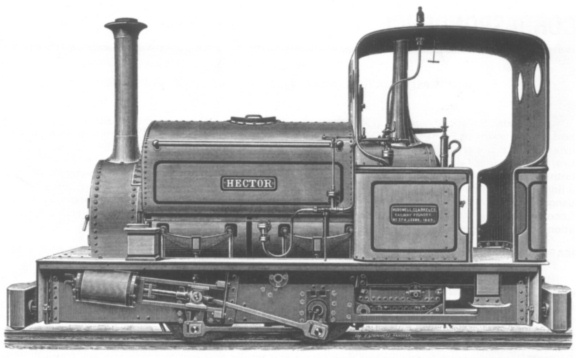
| THE INDUSTRIAL RAILWAY RECORD |
© AUGUST 1974 |
HECTOR

The above is 'a perspective view of one of four
neat little tank locomotives recently built by Messrs.
Hudswell, Clarke, & Co., of Leeds, for the 18 in.
gauge railway at Woolwich Arsenal. The engine has
outside frames and outside cylinders, the latter, which
are 7in. diameter by 12in. stroke, being connected by a
strong casting bolted between their valve chests so as
to insure a thoroughly firm fixing. The four wheels,
which are coupled, are 2ft.in diameter, and are of cast
iron with steel tyres. The axles are also of steel,
with, of course, outside bearings only. The boiler has a
barrel 2ft.3in. in diameter by 5ft.10½in. long, and is
provided with a copper firebox and thirty-six brass
tubes 2in. in diameter. On the boiler is placed a saddle
tank containing 200 gallons of water, while the coal-box
on the footplate has a capacity of 5% cubic feet. The
boiler is fed by one pump and one injector. The general
design of the engine is very neat, and the fittings are
complete and well arranged. The weight of the engine is
6% tons empty, and 8 tons in working order.'
'Mr. Albert Borsig, the well-known locomotive engineer of Berlin, died on the 10th of April, at the early age of forty-nine. The works were founded by his father in 1837, and since the beginning have turned out over 3600 locomotives for Germany, Russia, Sweden, Denmark, Holland and Austria, and for the Dutch Colonies. Mr. Borsig was one of the largest employers of labour, the number of his workmen at his Berlin works and at his iron and steel works and coal mines in Silesia exceeding 10,000. How successfully the works have been carried on is shown by the fact that Mr. Borsig's father began work with a capital of £1500, lent to him by a German tradesman, and that the son died one of the wealthiest men in Germany, having left property worth about three million sterling. Under the will of the late Mr. Borsig, the works will be conducted by a board of trustees, until his children (the eldest boy being only eleven years) become of
age.' ("Iron," 11th May 1878. – KPP)